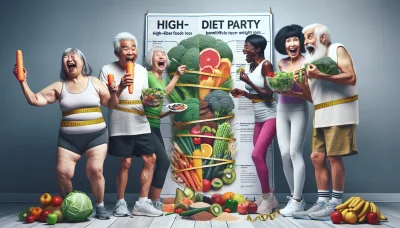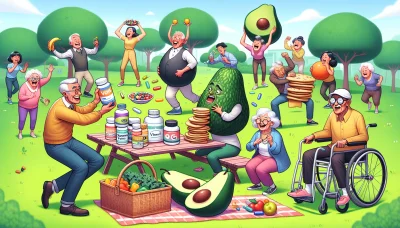Best nutritional supplements for elderly Quiz
Test Your Knowledge
Question of
Understanding Nutritional Needs of the Elderly
Assessing Dietary Requirements
As we age, our bodies undergo significant changes that affect our dietary needs. It's crucial for seniors and their caregivers to understand these shifts to maintain optimal health. Metabolism slows down, so energy requirements may decrease, but the demand for certain nutrients remains constant or even increases.
The caloric needs for seniors are different from those of younger adults. A sedentary lifestyle coupled with a slower metabolism means fewer calories are needed. However, each calorie consumed must be packed with nutrition to meet the body's needs without contributing to weight gain or nutritional deficiencies.
Hydration is a key concern for the elderly as the sense of thirst diminishes with age. Adequate fluid intake is essential to prevent dehydration, which can exacerbate chronic conditions and impact cognitive function. Seniors should aim for clear urine as a sign of proper hydration.
Essential Vitamins and Minerals
Vitamin D and calcium are pivotal in maintaining bone health for the elderly, reducing the risk of fractures and osteoporosis. Exposure to sunlight and dietary sources like fortified milk or supplements can help meet these requirements when natural intake falls short.
B vitamins play a critical role in cognitive health and energy production. Deficiencies can lead to memory issues and fatigue, making it imperative for seniors to consume adequate amounts through diet or supplementation. Foods rich in B vitamins include lean meats, eggs, and whole grains.
Antioxidants are warriors against cellular damage and support immune function. Seniors should focus on a diet rich in fruits and vegetables to ensure they're getting enough antioxidants to protect against chronic diseases and promote overall health.
Common Nutritional Deficiencies
Iron deficiency anemia is a common issue among the elderly, leading to fatigue and weakness. It's important to consume iron-rich foods like lean red meat, beans, and spinach, sometimes complemented by supplements under medical advice.
The ability to absorb vitamin B12 declines with age, which can result in neurological issues. Seniors need to be aware of this risk and ensure they're getting enough B12 from fortified foods or supplements if necessary.
- Omega-3 fatty acids : Essential for heart health, these fats are found in fish like salmon and sardines. Incorporating omega-3s into the diet can combat inflammation and support brain health.
- Vitamin D: With reduced sun exposure in seniors, vitamin D deficiency is prevalent. Supplements can be critical for maintaining healthy bones and supporting immune function.
- Fiber: : Often overlooked, fiber supports digestive health and can help manage blood sugar levels. High-fiber foods include whole grains, vegetables, and fruits.
Top Supplements for Healthy Aging
Multivitamins Tailored for Seniors
Seniors have unique nutritional needs, and that's where multivitamins step in to fill the gaps! These powerhouse supplements are tailored to support the health of men and women over 50. With age-targeted formulas, they ensure you're getting the right balance of vitamins and minerals your body craves.
It's not just about gender; these customized formulas take into account the specific health concerns that tend to arise as we age. They're precision-crafted to bolster bone density, enhance vision, and reinforce cognitive functiongiving your body a fighting chance against Father Time!
Let's face itour diets aren't always perfect. Multivitamins act as a nutritional safety net, ensuring seniors maintain an optimal balance of nutrients. They're the unsung heroes in the quest for healthy aging, working tirelessly to keep our bodies in equilibrium.
Probiotics for Digestive Health
A thriving gut flora is your ticket to stellar digestive health, and probiotics are just the conductors you need! These beneficial bacteria are key players in digestion, immunity, and even mental health. It's a gut feeling you can trustprobiotics are essential for a harmonious digestive tract.
Each probiotic strain serves a special function in this microscopic world inside us. From battling harmful bacteria to producing vitamins, these tiny allies wear many hats. By choosing the right strains, you can tailor your probiotic intake to address your specific health needs.
Probiotics don't just improve gut healththey also boost your body's ability to absorb nutrients from food. It's like upgrading your digestive system to first class! With better absorption comes better overall health, making probiotics a must-have in your supplement arsenal.
Omega-3 Supplements for Cardiovascular Support
Heart health is paramount, and omega-3 supplements are at the heart of cardiovascular support. The omega-3 fatty acids EPA and DHA are vital for maintaining a healthy ticker, reducing triglycerides, and keeping blood pressure in check. They're the guardians of your arterial highways!
Inflammation is a silent saboteur when it comes to agingbut fear not! Omega-3s are here to save the day by soothing inflammation throughout your body. This not only supports heart health but also keeps joint pain at bay. It's like oiling the cogs of your body machine!
- Fish Oil vs Plant-Based Sources: Fish oil is famous for its high omega-3 content but don't overlook plant-based sources like flaxseed or algae oilsespecially if you're vegetarian or allergic to fish!
- EPA and DHA: While both important, DHA is known for brain health whereas EPA is more associated with reducing inflammationchoose a supplement that provides both.
- Purity Matters: Always opt for supplements that are free from heavy metals and other contaminantsa pure product means pure benefits!
- Dosage: More isn't always better; consult with a healthcare provider to determine the right amount of omega-3s for your needs.
- Sustainable Sources: Consider the environment by choosing products sourced from sustainable fisheries or eco-friendly farms.
Dietary Adjustments for Enhanced Well-being
Incorporating Fiber-Rich Foods
Fiber is a powerhouse when it comes to promoting health and well-being. Incorporating fiber-rich foods into your diet can aid digestion, help control blood sugar, and even reduce the risk of heart disease. It's an essential component that many diets lack, but with focused effort, it's easy to increase your intake.
There are two types of fiber: soluble and insoluble. Soluble fiber, found in oats, beans, and fruits, helps to lower cholesterol and stabilize blood sugar levels. Insoluble fiber, present in whole grains and vegetables, improves bowel movements by adding bulk to stool. Both types are crucial for digestive health.
Increasing your fiber intake can sometimes lead to digestive issues such as bloating or gas. To manage these potential side effects, start slowly and build up your intake gradually. Also, remember to drink plenty of water to help fiber do its job effectively.
Reducing Sodium for Blood Pressure Control
High sodium intake is a silent contributor to hypertension and cardiovascular diseases. Reducing sodium in your diet can have a profound effect on lowering blood pressure and maintaining heart health. It starts with being mindful of the sodium content in the foods you consume.
- Read food labels carefully sodium hides in unexpected places like breads and cereals.
- Cook more meals at home this gives you full control over the amount of salt used.
- Choose fresh or frozen vegetables over canned ones which often contain added salt.
- Be cautious with condiments like soy sauce or ketchup; opt for low-sodium versions.
Exploring salt substitutes can also be beneficial. Herbs and spices add flavor without increasing sodium intake. Lemon juice, garlic, and pepper are just a few examples that can enhance the taste of your meals without compromising your health.
The impact of sodium on hypertension cannot be overstated. Consistently high levels of sodium can lead to chronic high blood pressure, which damages the heart over time. Making dietary adjustments early on is key to prevention and management of hypertension.
Balancing Protein Intake
Maintaining an adequate protein intake is vital for muscle repair, immune function, and overall body maintenance. High-quality protein sources include lean meats, dairy products, eggs, and plant-based options like legumes and quinoa. Balancing these sources ensures that all the amino acids necessary for good health are consumed.
The debate between plant versus animal proteins often centers around their respective health benefits. Plant proteins tend to be lower in saturated fat and higher in fiber compared to animal proteins. However, animal proteins generally contain all essential amino acids in one package.
Protein needs vary depending on one's lifestyle; active individuals require more protein than those who lead sedentary lives. Seniors especially need adequate protein for muscle maintenance but must balance their intake with other nutritional needs unique to aging bodies.
Special Diets and Their Impact on Senior Health
Mediterranean Diet for Heart Health
The Mediterranean diet is a heart-healthy eating plan that emphasizes fresh fruits, vegetables, whole grains, and healthy fats. It's been shown to reduce the risk of heart disease and improve longevity in seniors. Rich in nutrients and low in processed foods, this diet supports a robust cardiovascular system.
Key Components of the Mediterranean Diet include a variety of plant-based foods such as leafy greens, nuts, and legumes. Whole grains are consumed regularly while red meat is limited. The diet promotes moderate wine consumption, which has been linked to heart health benefits.
Olive Oil and Healthy Fats are central to the Mediterranean diet. Replacing butter with olive oil can reduce bad cholesterol levels. Additionally, the high content of omega-3 fatty acids found in fish contributes to a reduced risk of heart-related issues.
Incorporating Seafood and Lean Meats into your diet at least twice a week is recommended. Poultry, eggs, cheese, and yogurt should be enjoyed in moderation, while red meat should be limited to just a few times a month.
Anti-Inflammatory Diets to Combat Chronic Diseases
An anti-inflammatory diet can play a crucial role in managing chronic diseases common in seniors. This diet focuses on foods that reduce inflammation markers in the body, which may contribute to conditions like arthritis and heart disease.
Foods That Fight Inflammation include tomatoes, olive oil, green leafy vegetables such as spinach and kale, nuts like almonds and walnuts, fatty fish such as salmon and mackerel, and fruits like strawberries, blueberries, cherries, and oranges.
- Avoid refined carbohydrates like white bread and pastries.
- Limit fried foods and other foods high in saturated fats.
- Cut back on sugary beverages and processed snacks.
- Steer clear of red meat (burgers, steaks) and processed meat (hot dogs, sausage).
The Role of Spices in Reducing Inflammation cannot be overstated. Turmeric and ginger are known for their anti-inflammatory properties. Incorporating these spices into your meals can help manage inflammation levels effectively.
DASH Diet for Hypertension Management
The DASH diet is an effective dietary approach to stop hypertension. It emphasizes reducing sodium intake while increasing potassium-rich foods which help control blood pressure levels. Seniors following this diet can expect improvements in their blood pressure readings within weeks.
Understanding the DASH Eating Plan involves recognizing the importance of calcium, potassium, fiber, protein while cutting back on fats and red meats. The plan also focuses on portion controleating more frequent but smaller meals throughout the day to maintain stable energy levels.
Low-Sodium Choices and Portion Sizes are vital components of the DASH diet. Opting for fresh or frozen produce without added salt or sauces can make a significant difference in sodium intake. When it comes to portion sizes, using smaller plates can help prevent overeating.
Emphasis on Whole Grains, Fruits, and Vegetables ensures that those following the DASH diet get sufficient fiber which aids digestion and contributes to overall well-being. Including a variety of these food groups also ensures that all necessary vitamins and minerals are consumed.
Meal Planning Strategies for the Elderly
Creating Balanced Meal Plans
For the elderly, a balanced meal plan is crucial to maintain health and energy levels. It's important to include a variety of foods that provide essential nutrients. A focus on whole grains, lean proteins, fruits, vegetables, and low-fat dairy can help meet these needs. Integrating colorful foods ensures a range of vitamins and minerals are consumed.
Macronutrient Ratios for Optimal Health are key in meal planning for the elderly. The ideal plate should consist of 50% fruits and vegetables, 25% whole grains, and 25% protein sources. This ratio supports muscle maintenance and energy while aiding digestion. Healthy fats from sources like avocados and olive oil should also be included in moderation.
Sample Meal Ideas for Breakfast, Lunch, and Dinner : Start the day with oatmeal topped with berries and nuts; lunch could be a turkey wrap with mixed greens and quinoa salad; dinner might feature grilled salmon with steamed broccoli and sweet potatoes. These meals encompass all macronutrients and provide sustained energy.
Snack Options That Support Overall Nutrition include Greek yogurt with honey, apple slices with almond butter, or a handful of mixed nuts. Snacks should be seen as an opportunity to fill nutritional gaps from main meals.
Overcoming Common Eating Challenges
Solutions for Decreased Appetite : It's common for appetite to wane as we age. To combat this, focus on small, nutrient-dense meals throughout the day rather than three large ones. Flavorful herbs and spices can enhance appeal without adding excessive salt or sugar.
Managing Chewing or Swallowing Difficulties : Soft foods like mashed potatoes or scrambled eggs can alleviate discomfort while ensuring nutrient intake. Blended soups or smoothies are also excellent options that are easy to consume and can be packed with vitamins and minerals.
Adapting Meals for Specific Health Conditions : It's vital to tailor meals according to any health conditions. Diabetes may require carbohydrate control, while heart conditions necessitate low-sodium options. Always consult a dietitian or healthcare provider when planning meals for specific health needs.
Shopping Tips for Nutrient-Dense Foods
Reading Nutrition Labels Effectively : Understanding labels is critical in selecting nutritious foods. Look for low levels of saturated fat, sodium, and added sugars while seeking out high fiber, vitamin, and mineral contents. Knowledge of serving sizes is also essential to avoid overeating.
Budget-Friendly Nutritious Shopping : You don't have to break the bank to eat healthily. Purchasing generic brands, buying in bulk, and choosing frozen or canned produce (with no added sugars or salts) can save money without compromising on nutrition.
- Seasonal Produce Selection for Peak Nutrition: Selecting seasonal fruits and vegetables not only ensures peak flavor but often comes with a lower cost due to abundance.
- Farmers' markets are great places to find fresh seasonal produce while supporting local agriculture.
- Incorporating seasonal items into meal plans brings variety throughout the year and maximizes nutrient intake.
- Maintaining a kitchen garden with herbs and simple vegetables like tomatoes can provide fresh ingredients right at your doorstep.
The Role of Hydration in Elderly Nutrition
Recognizing Signs of Dehydration
Physical Symptoms of Inadequate Hydration can range from dry mouth to severe muscle cramps. Elderly individuals often experience a diminished sense of thirst, which can lead to chronic dehydration without noticeable warning signs until it's severe. Regular monitoring for symptoms such as reduced urine output or darkened urine is crucial.
Cognitive Effects of Dehydration are particularly concerning in the elderly. Mild dehydration can cause confusion, drowsiness, and memory problems. It's imperative to address these symptoms quickly as they can mimic or exacerbate dementia-related behaviors, potentially leading to misdiagnosis or unnecessary medication adjustments.
Strategies for Monitoring Hydration Levels include keeping a hydration schedule and using tools like urine color charts. Caregivers should encourage regular fluid intake throughout the day, rather than relying on the elderly person's sense of thirst, which may not be reliable.
Healthy Beverage Choices
Water as the Primary Source of Hydration is irreplaceable. It's calorie-free, cost-effective, and readily available. For elderly individuals, water should be easily accessible at all times to encourage frequent sipping, especially for those with limited mobility.
Herbal Teas and Their Benefits : Herbal teas are a fantastic alternative to plain water. They offer a variety of flavors and potential health benefits, including aiding digestion and promoting relaxation, without the detrimental effects of caffeine.
- Avoid beverages with high sugar content as they can lead to spikes in blood sugar levels.
- Limit caffeine intake as it can contribute to dehydration by increasing urine production.
- Incorporate beverages with electrolytes for individuals who sweat profusely due to climate or physical activity.
- Be wary of "diet" drinks that contain artificial sweeteners; opt for natural flavorings instead.
Hydration and Medication Management
Interactions Between Medications and Hydration Status : Some medications can alter hydration needs. For example, laxatives and certain blood pressure medications increase fluid loss. It's essential for healthcare providers to review each patient's medications regularly to ensure hydration needs are being met.
Adjusting Fluid Intake When on Diuretics : Diuretics commonly prescribed for heart conditions or high blood pressure increase urine production, which can lead to rapid dehydration if fluid intake isn't increased accordingly. Monitoring weight and electrolyte levels can help manage this balance.
The Importance of Consistent Fluid Intake : Sudden changes in fluid intake can affect medication efficacy and overall body function. Seniors should strive for consistent daily water intake, adjusting only under medical advice. This consistency helps maintain medication effectiveness and supports kidney function.
Navigating Dietary Restrictions and Allergies
Identifying Common Food Allergies and Intolerances
Understanding food allergies and intolerances is crucial for maintaining a safe and healthy diet. Identifying which foods cause adverse reactions can help in creating a tailored eating plan. Common culprits include dairy, nuts, shellfish, wheat, and soy. Recognizing symptoms early on leads to better management of dietary restrictions.
Gluten Sensitivity and Celiac Disease : Gluten sensitivity presents with symptoms like bloating and abdominal pain, while celiac disease is an autoimmune disorder triggered by gluten. For those affected, eliminating gluten from the diet is essential to prevent damage to the small intestine and alleviate symptoms.
Lactose Intolerance Management : Lactose intolerance stems from the body's inability to digest lactose found in dairy products. Symptoms include gastrointestinal discomfort after consuming dairy. Alternatives like lactose-free milk or plant-based substitutes provide viable options for those affected.
Nut Allergies and Safe Alternatives : Nut allergies can be life-threatening, requiring strict avoidance of nuts. For cooking and baking, seeds like sunflower or pumpkin can be safe alternatives, as well as nut-free butters derived from soy or peas.
Strategies for Elimination Diets
An elimination diet involves removing suspected allergens from your diet then gradually reintroducing them to pinpoint triggers. It's a methodical approach that requires patience but can significantly clarify individual dietary needs.
Implementing a Step-by-Step Elimination Process : Begin by cutting out common allergens for several weeks. Keep a detailed food diary during this phase to track what you eat and any changes in symptoms.
Monitoring Symptoms and Reactions : Vigilant observation during an elimination diet is key. Any changes in health, mood, or physical reactions should be noted to assist in identifying problematic foods when they are reintroduced.
- Keep a comprehensive journal tracking food intake and symptoms.
- Avoid cross-contamination by thoroughly reading food labels.
- Maintain nutritional balance by finding alternative sources of essential nutrients.
- Consult with healthcare providers before starting an elimination diet.
- Be patient some symptoms may take time to resolve after eliminating the trigger food.
Adapting Recipes to Dietary Needs
Adapting recipes for dietary restrictions doesn't have to mean sacrificing flavor or enjoyment. With creativity and the right resources, delicious alternatives are within reach.
Finding Substitute Ingredients : Substitutes can often mimic the taste and texture of restricted ingredients. For example, applesauce or mashed bananas can replace eggs in baking, while nutritional yeast can offer a cheesy flavor without dairy.
Gluten-Free Baking Techniques : Gluten-free baking is an art form that often requires blends of alternative flours like rice or almond flour. Xanthan gum is frequently used as a binding agent in place of gluten to achieve desirable textures in breads and pastries.
Dairy-Free Cooking Tips : Dairy-free cooking has become easier with numerous plant-based milks and creams available on the market. Coconut oil or vegan butter can stand in for butter, while cashew cream provides a rich base for sauces and soups without dairy.
Staying Informed on Nutritional Trends and Research
Evaluating the Credibility of Nutritional Information
With the deluge of nutritional advice available today, it's crucial to discern what's credible. Not all information is created equal, and some can be misleading or even harmful. It's vital to seek sources that base their recommendations on scientific evidence rather than anecdotal success stories. Look for credentials such as registered dietitians or certified nutritionists when evaluating advice.
Distinguishing between well-researched guidance and passing fads can be challenging. A fad often promises quick fixes and lacks scientific backing. Conversely, science-based advice is grounded in rigorous research and acknowledges that real results take time. It also considers the complexity of human health, rather than offering one-size-fits-all solutions.
Understanding peer-reviewed studies is a game-changer in evaluating nutritional information. These studies have undergone scrutiny by experts in the field before publication, ensuring a higher level of credibility. However, not all peer-reviewed research is free from bias or flaws; it's still important to consider who funded the research and to look for corroborating studies.
To access reliable nutritional data, utilize resources like government health departments, university research centers, and reputable health organizations. They provide information that's been thoroughly vetted and updated regularly to reflect the latest scientific findings.
The Impact of Emerging Superfoods
A superfood is typically nutrient-rich and considered particularly beneficial for health and well-being. While there's no official scientific definition, superfoods are often loaded with antioxidants, vitamins, and minerals that can help ward off diseases.
The evidence behind trendy superfoods can vary widely. Some have been well-studied and shown to offer significant health benefits, while others may ride the wave of media hype without robust support from research. It's important to scrutinize claims and seek out balanced evaluations of these foods.
- Research thoroughly before jumping on superfood trends.
- Be skeptical of exaggerated health claims without scientific backing.
- Remember that no single food can offer all dietary needs.
- Incorporate a variety of nutrient-rich foods for balanced nutrition.
- Consult healthcare professionals when making major dietary changes.
Incorporating superfoods into your diet should not overshadow the importance of a balanced diet. While these foods can contribute beneficial nutrients, they are most effective as part of diverse eating patterns that include a wide range of fruits, vegetables, whole grains, lean proteins, and healthy fats.
Keeping Up with Dietary Guidelines and Recommendations
Governments regularly update dietary guidelines to reflect new nutritional research findings. These updates are designed to provide populations with frameworks for healthy eating patterns. Staying informed about these changes ensures that dietary practices remain aligned with current knowledge.
Professional health organizations also play a critical role in disseminating updated dietary recommendations. Organizations such as the American Heart Association or the Academy of Nutrition and Dietetics provide resources tailored to specific health conditions or population groups, which can be incredibly valuable for personalized advice.
Applying generalized guidelines to individual health needs requires customization. Factors like age, gender, activity level, existing health conditions, and personal goals all influence nutritional requirements. Personalization might involve working with healthcare providers to translate broad recommendations into actionable steps tailored to your unique circumstances.












